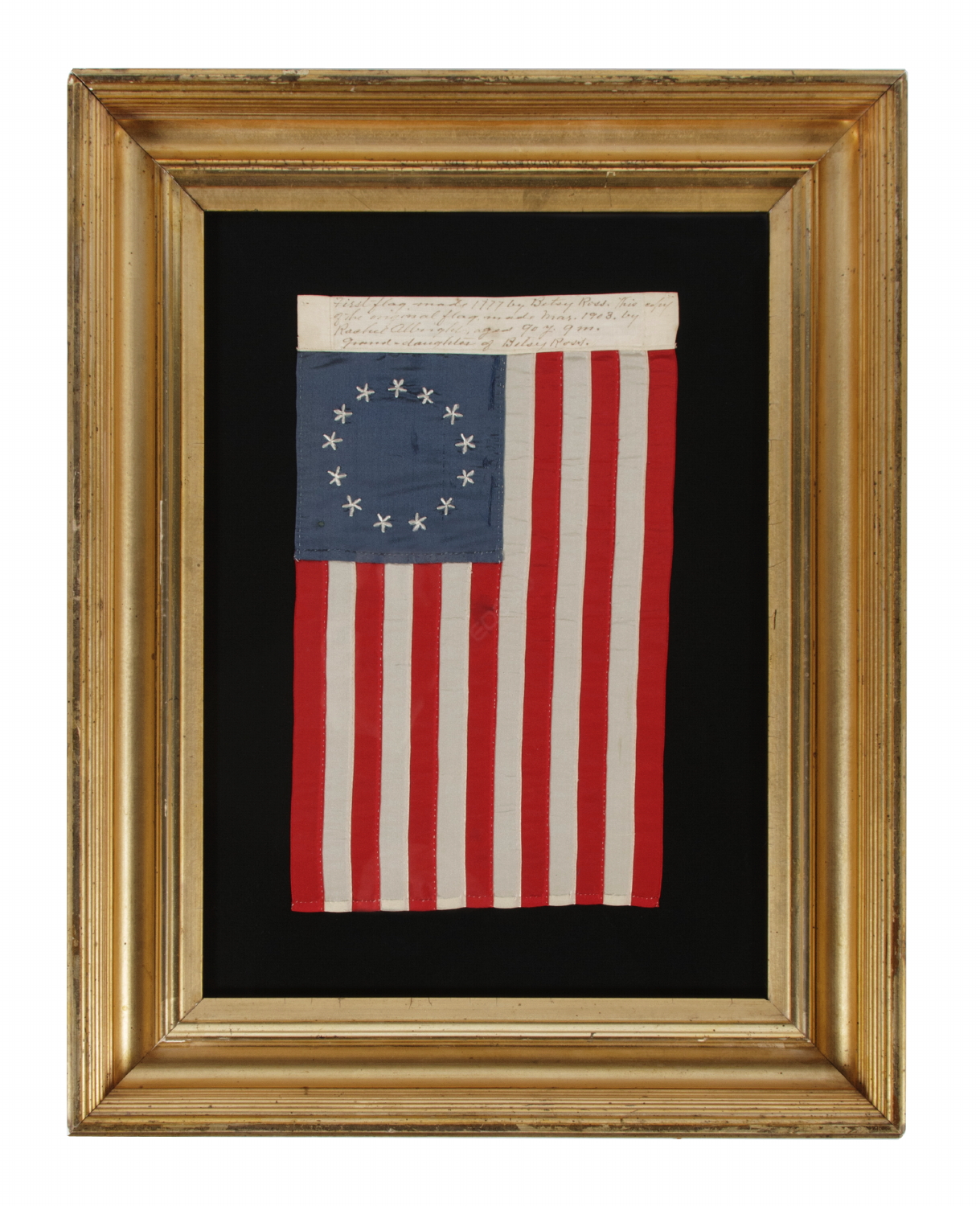
| |
13 STAR FLAG WITH EXPERTLY HAND-SEWN STRIPES AND EMBROIDERED STARS, MADE BY RACHEL ALBRIGHT, GRANDDAUGHTER OF BETSY ROSS, IN PHILADELPHIA IN 1903 |
|
| Available: |
Sold |
| Frame Size (H x L): |
20.25" x 16.25" |
| Flag Size (H x L): |
12" x 7.5" |
|
| Description....: |
|
13 STAR FLAG WITH EXPERTLY HAND-SEWN STRIPES AND EMBROIDERED STARS, MADE BY RACHEL ALBRIGHT, GRANDDAUGHTER OF BETSY ROSS, IN PHILADELPHIA IN 1903:
13 star American national flag, entirely hand-sewn by Rachel Wilson Albright, granddaughter of Betsy Ross. The stripes are constructed of silk ribbon carefully pieced with tiny stitches and a degree of precision seldom seen on American textiles. The five-pointed stars are executed with lineal lines like a spokes on a carriage wheel or the rowel of a spur. These are constructed of silk floss on a canton made of blue silk taffeta, and there is a hand-sewn cotton binding along the hoist. The stripes of the flag are constructed of silk ribbon and hand-sewn with especially tiny stitches. The five-pointed stars are executed with lineal lines like a spokes on a carriage wheel or the rowel of a spur. These are constructed of silk floss on a canton made of blue silk taffeta. There is a wide, treadle-sewn binding along the hoist, which is signed with a dip pen in the following manner:
"First flag made 1777 by Betsy Ross. This copy of the original flag made Mar. 1903. by Rachel Albright, aged 90 y. 9 m. grand-daughter of Betsy Ross."
Beginning around 1898, Rachel, began producing flags like this one in the East Wing of Independence Hall in Philadelphia. She sold them to tourists and probably sometimes gifted them to individuals who made donations to the American Flag House and Betsy Ross Memorial Association. She was elderly and sometime around 1902, as her health began to fail, she was joined by Sarah Wilson, Betsy's great-granddaughter, and the two women operated their tiny cottage industry until 1905, when Rachel relocated to Fort Madison, Iowa. She passed in 1907. Sarah continued in the trade until around 1913.
The Albright and Wilson flags are extraordinary because of their tiny size and silk, hand-sewn construction. They are extremely easy to identify because their characteristics are so distinctive. There is nothing else like them among 13 star flags made during this period. That having been said, they were individually made and do exhibit a small degree of personalized variation. The sleeves or hoist bindings vary in width and some have tiny, hand-sewn grommets.
These flags typically either came with a separate note or a direct signature, such as this one. The bold signature on the broad sleeve of this example, written on one side only so it can be readily viewed in full, is of substantial interest. The signatures on Sarah's flags, in contrast, begin on the obverse (front) and continue on the reverse. Rachel's flags were also generally larger than Wilson's and so make for a bolder presentation.
Rachael and Sarah proudly proclaimed that this is what the original flag looked like, with a perfect wreath of 13 stars, but no hard evidence exists to substantiate it. In fact, no one knows precisely what the star configuration was on the first flag, but it is unlikely that it had a perfect circle of stars. Of the very few colonial examples that survive, none are in this pattern. Further, while there are thousands of 13 star flags that still exist today, having been made during the 19th century for all manner of patriotic and utilitarian purposes, almost none made prior to the 1890’s survive that have their stars arranged in a “Betsy Ross”, perfect circle pattern. The Albright and Wilson flags are among the very first to be produced in this design and are probably responsible for the fact that this pattern is now so popularly connected with the Ross name. In other words, flags in this pattern made afterwards were probably copied from the Ross Granddaughter flags.
One of these small flags appears on the Betsy Ross House website (http://www.ushistory.org/betsy/house/room9.html). A signed example is picture in “The Stars and the Stripes” by Mastai, (1973, Knopf, New York), p. 228.
Mounting: The gilded, American molding dates to the period between 1840 and 1870. This is a pressure mount between 100% cotton twill, black in color, and U.V. protective acrylic. The black fabric has been washed to reduce excess dye. An acid-free agent was added to the wash to further set the dye and the fabric was heat-treated for the same purpose.
Condition: There are two small splits in the blue canton, accompanied by a couple of much tinier ones. There is very minor soiling near the center of the 4th red stripe. There are tiny, pinprick-sized tack holes in the extreme top and bottom outside corners of the hoist binding. Overall this is an excellent state of preservation among known examples of Albright and Wilson flags. |
|
|
|
| Collector Level: |
Advanced Collectors and the Person with Everything |
|
| Flag Type: |
Sewn flag |
|
| Star Count: |
13 |
|
| Earliest Date of Origin: |
1903 |
|
| Latest Date of Origin: |
1903 |
|
| State/Affiliation: |
Pennsylvania |
|
| War Association: |
|
|
| Price: |
SOLD |
|
| |
Views: 2347 |
|
|
|

